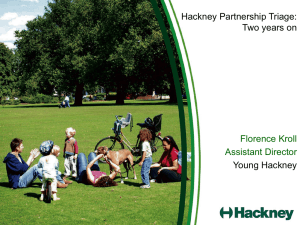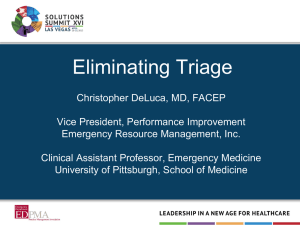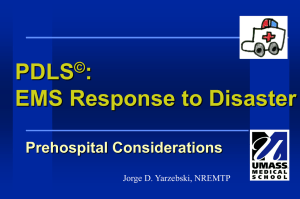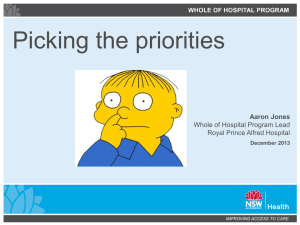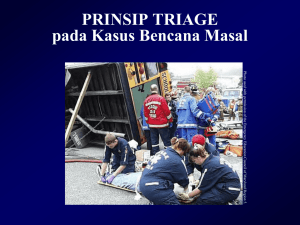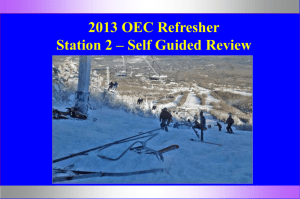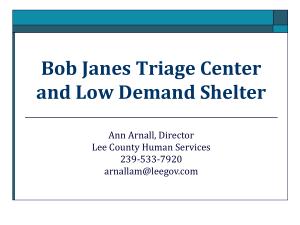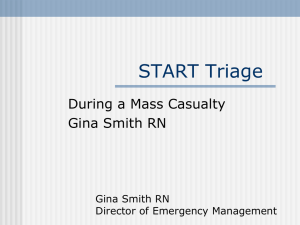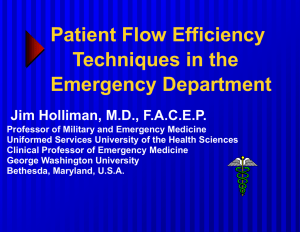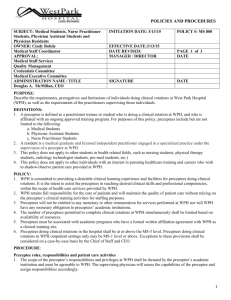Assessing the acute oncology patient Who, why, where and how!
advertisement
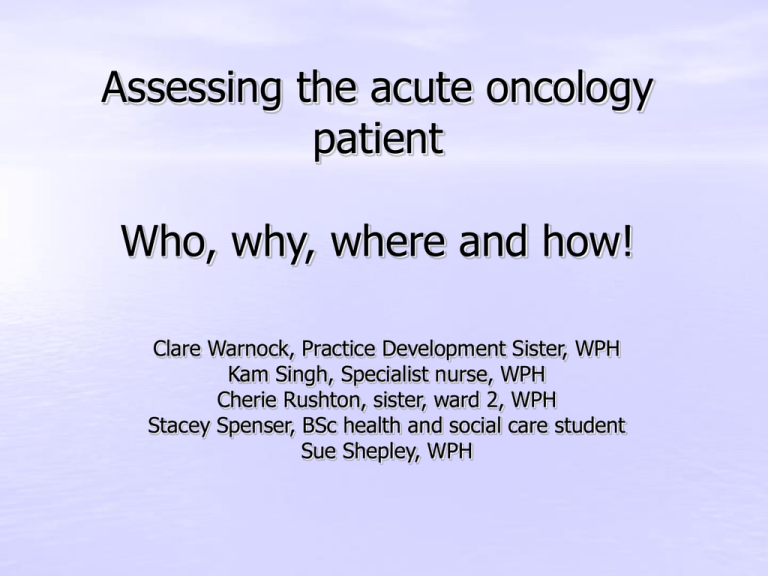
Assessing the acute oncology patient Who, why, where and how! Clare Warnock, Practice Development Sister, WPH Kam Singh, Specialist nurse, WPH Cherie Rushton, sister, ward 2, WPH Stacey Spenser, BSc health and social care student Sue Shepley, WPH Aim of this session • Provide insight into the AOS needs of patients within the NT cancer network – How many patients seek AOS support – Which patients seek advice – Why do they need help – What type of support do they need – How do we currently provided AOS support – What tools do we have to help Triage assessment • Triage = the process of determining the priority of • • • • • • patients' treatments based on the severity of their condition UKONS standards for triage - what do we have in place? The triage practitioner has the right of admission √ There should be an identified assessment area √ There should be a clearly identified triage practitioner for each span of duty √ There should be a process for each step of the triage pathway √ Each step provides insights into the AOS service Triage pathway Triage Practitioner Triage and log Sheet Attend for assessment WPH or A&E Follow assessment guidelines advice on appropriate care location/service. e.g. pharmacy, GP, self monitor Advice/reassurance Who is using the service? How many calls do we receive? • 4 reviews have been carried out at WPH – – – – – October 2009 = 129 calls October 2010 = 291 calls April 2012 = 483 April 2013 = 544 July 2013 = 562 • The number of calls per month and per day vary widely on tu 1 es w 2 ed th 3 ur s 4 fri 5 sa t6 su n m 7 on tu 8 es w 9 ed th 1 0 ur s 11 fri 1 sa 2 t1 su 3 n m 14 on tu 15 es w 16 ed th 1 7 ur s 18 fri 1 sa 9 t2 su 0 n m 21 on w 22 ed th 2 3 ur s 24 fri 2 sa 5 t2 su 6 n m 27 on tu 28 es w 29 ed th 3 0 ur s 31 m number of calls Number of calls per day (July 2013) 30 25 20 15 10 5 0 Time of day of calls 160 140 120 100 80 60 40 20 0 00:00 01:00 02:00 03:00 04:00 05:00 06:00 07:00 08:00 09:00 10:00 11:00 12:00 13:00 14:00 15:00 16:00 17:00 18:00 19:00 20:00 21:00 22:00 23:00 Challenge of unpredictable demands • There was a wide variation in volume of • • telephone calls each month and each day – We did not find a pattern The service need to meet a highly unpredictable workload This presents a challenge faced when trying to plan and deliver oncology telephone triage services Which patients use the phone service Where do patients live (2009)? Primary diagnosis of patients 120 100 80 60 40 20 0 Breast Lung Colorectal Gynae Prostate Upper GI Lymphoma Brain Kidney Head and Melanoma neck Recent treatment (2013) 63, 12% 7, 1% 37, 7% 31, 6% 409, 74% Chemotherapy Radiotherapy New pt/no treatment in past 6 weeks Not documented Other In f tio ec n tio ec PI C an d /fo ot xia 5 H or e es tio n 7 An h as h ou t R m 8 ig te 10 In d re si le m s a pr ob ul io n 15 So C an n at 20 C tip on s 30 C ng oe a itt i ia rrh om /v l 50 D ea au s 70 N te m p 60 re xi a ap y wi th s, n m pt om sy In f Reason for ringing (2013) Chemotherapy treatment related 80 70 59 49 40 29 18 15 4 0 1 Other common reasons for ringing (all patients) • Pain = 55 • Major illness = 45 – E.G. chest pain, deranged U&E, bowel obstruction, spinal cord compression, sudden confusion • Medicines advice = 33 • Minor ailments = 40 – E.G. Small bleed, infected toe, constipation, sore eye • General query = 18 – E.G. DN fax, appointment query, dental advice • Radiotherapy side effects = 10 • What happens when a patient or relative rings for advice? Triage pathway Triage Practitioner Attend for assessment Cancer centre, A&E Follow assessment guidelines - advice on appropriate care location/service. e.g. pharmacy, GP, self monitor Advice/reassurance How to decide assessment outcomes? • Tools for triage – Telephone triage – based on UKONS triage guidelines – AOS guidelines • Based on assessment of symptom severity and clinical signs – With elements of experience, intuition and hunches • Colour coded grading of – Minor (green) – Moderate (amber) – Severe (red) Action following assessment • Green – follow advice on guidelines. • 1 amber – follow advice in guidelines. • Ask patient to ring back if symptoms do not • improve or worsen 2 or more amber – organise appropriate medical review – WAU, GP, local A&E, next OPA • Red – medical review at WPH unless alternative appropriate – e.g. A&E for cardiac chest pain, conditions that might require surgical intervention Temperature 37.5oc or more, OR symptoms of infection OR feels generally unwell Assessment questions 1.What is the patients’ temperature? 2.How long have they had a temperature? 3.Have they had any shivers or shaking? 4.Do they have any other symptoms? 5.Have they taken paracetamol or NSAID that could mask a pyrexia? Arrange urgent medical review as risk of neutropaenic sepsis – follow neutropaenic sepsis pathway. If no bed available at WPH send to local A&E. Phone A&E to inform staff of patients arrival and need to follow the neutropaenic sepsis protocol including urgent bloods and IV antibiotics within 1 hour if neutropenic sepsis suspected ALERT patients on steroids/analgesics or dehydrated may not present with pyrexia but may still have an infection Bleeding or bruising Assessment questions 1.Is it is new problem? 2.Are they on anticoagulation or aspirin? Severity level 1 Small volume blood loss, self limited, controlled by conservative Bleeding measures e.g. 1.Is it continuous? How long stops easily for? and quickly on 2.Volume of blood loss applying 3. Where is it from? pressure 4.Is there a cause or is it Small bruise spontaneous? where cause of bruise is Bruising known 1.Extent of bruising? Where on the body? 2.has their been an injury? Severity level 2 Moderate volume blood loss or bleeding on more than one occasion. Spontaneous bruising /large areas of bruising particularly where the cause is not known (need to check platelet count) Severity level 3 and 4 Large volume blood loss or continuous or prolonged Arrange urgent medical review. Review may be at local A&E if appropriate or likely to require surgical or specialist intervention e.g. vaginal bleeding with gynaecology primary, haematemesis, resuscitation/ critical care team support Arrange urgent medical review at local A&E via 999 ambulance as likely to require surgical or specialist intervention e.g. immediate resuscitation/critical care team support Nausea 1.How long have they had nausea? 2.Are they taking antiemetics as prescribed? 3.What is their oral intake? 4.Are there any signs of dehydration e.g. decreased urine output, thirst, dry mucous membranes, weakness, dizziness, confusion? 5.Do they have any other symptoms e.g. stomach pain, abdominal distension, diarrhoea? (If yes, refer to appropriate guidelines) Able to eat and drink, managing a reasonable oral intake Can eat/drink but intake reduced, no signs of dehydration Patient symptomatic of dehydration /haemodynamic instability or patient unable to take adequate oral fluids Give advice on prescribed antiemetics including regular use and compliance with prescription. Advise to take frequent sips of fluid and eat small amounts often. Teach patient to monitor for signs of dehydration. Arrange medical review of anti-emetics. May not need to attend WPH if appropriate to contact GP for new prescription of antiemetics or S/C or IM anti-emetics If on capecitabine discuss dose reduction/ discontinuing with on call registrar/ patients medical team. Arrange urgent medical review at WPH. If no bed available at WPH send to local A&E. Phone A&E to inform staff of chemotherapy related antiemetic protocol If on capecitabine or 5FU infusor discuss discontinuing with registrar/patients medical team. Palmar- plantar (hand-foot) syndrome (PPE) 1.How many days? 2.What areas are affected? 3.Is there any pain? 4.Is the skin broken? 5.Does it interfere with mobility/normal activity? 6.Is the patient on oral medication likely to be causing this – i.e. capecitabine, Sunitinib, Sorafenib Numbness, tingling, painless erythema, swelling, not disrupting normal activity Painful erythema and swelling, discomfort that affects normal activity but still able to perform them Advise use of emollient cream. If on capecitabine or other Advise use of oral cancer treatment that emollient can cause PPE discuss cream. dose reduction/ (e.g. Diprobase, discontinuing with or E45) registrar/patients medical team. Moist desquamation, ulceration, blistering, severe pain, unable to perform normal activities Organise admission and medical review If on capecitabine or other medication that can cause PPE discontinue and discuss with registrar/patients medical team. AOS assessment and treatment guidelines • Local guidelines have been developed • WPH guidelines are accessible on th intranet What are the outcomes of the calls? Outcomes of calls (2013) Phone advice, 177, 34% Other, 44, 8% A&E, 46, 8% GP, 121, 22% WAU, 154, 28% Are we getting it right? • 3 reviews have evaluated whether phone advice was appropriate • 2009 = 84.4% appropriate – Incorrect advice = 7 – Not enough information documented = 7 • 2010 = 87.2% appropriate – Incorrect advice = 17 – Not enough information = 6 • 2012 = 92% appropriate – Incorrect advice = 12 – Not enough information = 21 • Which patients attend the cancer centre for review? Attending for review • Patients attend WAU for medical review – 8 bedded unit • Figures for January to July 2011 – range 96 to 189 per month (mean 136) • Review January 2013 – 206 patients • September 2013 – 231 patients Number of patients per day (September 2013) Time of day that patients arrived (September 2013) The num ber of em ergancy adm issions by area Where do patients live (2013) for January 2013 100 80 60 40 20 O th er 0 Ba rn sl ey C he st er fie ld D on ca st er R ot he rh am Sh ef fie ld W or ks op Patients Admitted 120 Reason for treatment related admissions (June 2011) Reason Total Suspected neutropenic sepsis 53 Nausea and vomiting 21 Infection not neutropenic 20 Diarrhoea 17 Electrolyte imbalance/dehydration 11 Head and neck radiotherapy symptom management 9 Pancytopenia/low platelets/symptomatic anaemia 6 Other (PICC problems, oesophagitis, extravasation) 4 Total 141 Non treatment related reasons for patients on active treatment in the past 6 weeks Reason Total Pain and symptom management 8 Oncology emergency e.g. collapse, seizure, haemoptysis, obstruction, Disease related symptoms e.g. jaundice, confusion 6 End of life care 3 Pulmonary embolus 2 Problem with paracentesis drain site 1 Total 26 6 Patients who had not received active treatment in the last 6 weeks Reason Total Pain control 6 End of life care 4 Other 6 Total 16 What care do patients need on WAU? – Medical and nursing assessment – Cannulation, IV fluids, medicines administration (oral, IV and IM), urinary catheterisation, phlebotomy – Tests and investigations – Information and support • explanation of treatments/condition, updating on the treatment plan – Consultation with senior medical staff/patients own consultant team – Transfer to wards How does the service measure up? • Three key activities were identified – observations, blood tests and cannulation. • Time for admission to observations – Range 3 minutes to 10 minutes, average 6.4 minutes • Time from admission to blood tests – Range 5 minutes to 30 minutes, average 15.2 minutes • Time from admission to Cannulation – Range 15 to 30 minutes, average 21.25 minutes Where dopatients patients goto during next? January w ere discahrged The location 2013 Number of patients 80 70 60 50 40 30 20 10 0 Home Ward 2 Ward 3 TCU Other Location Challenges of AOS and triage • Workload is variable and unpredictable • Can be a struggle to provide the service when busy • • – Undermines effectiveness and safety if not managed Example of challenges: – Next call waiting while taking calls, – No time for review for patient on the phone • e.g. check ICE – Fitting in other roles (e.g. managing WAU and triage) Patient triage and assessment isn’t easy! – requires skill and experience Is it worth it? • It IS proving to be a valuable resource for patients – Provides timely access to specialist advice and treatment – Prevents inappropriate admissions – Allays unnecessary patient anxiety – Valuable safety net • But it is a Challenging service to provide – Triage has never been funded as a separate service and has developed from existing resources – Its success over time means this should be reviewed as it is outgrowing the resources available

